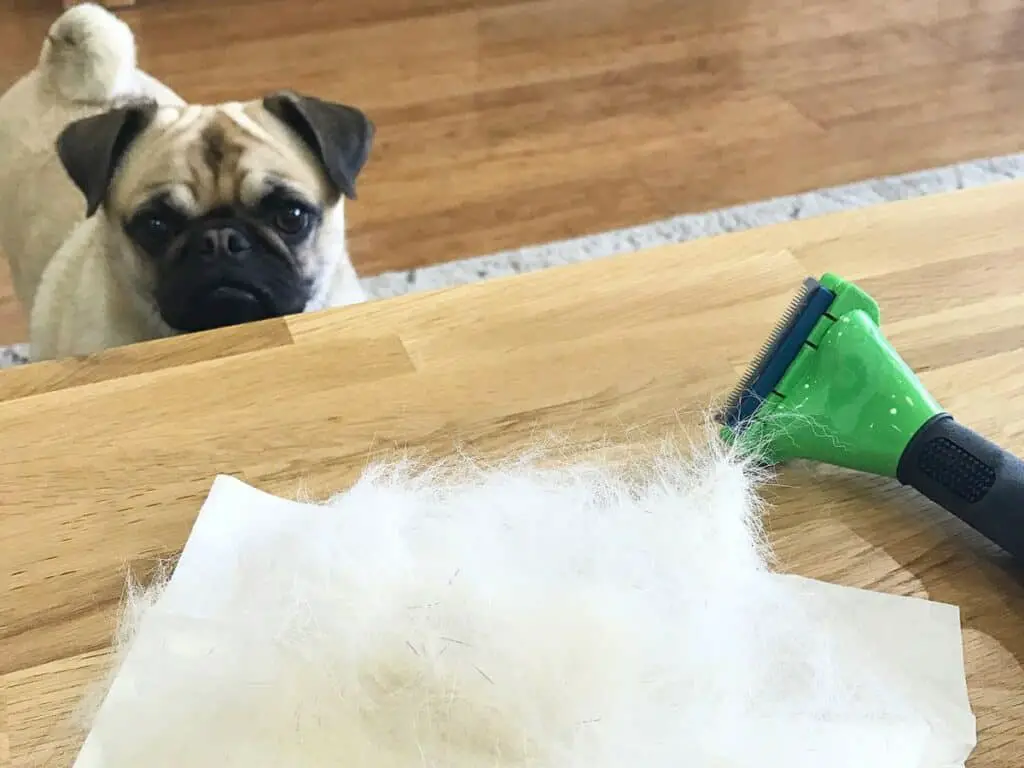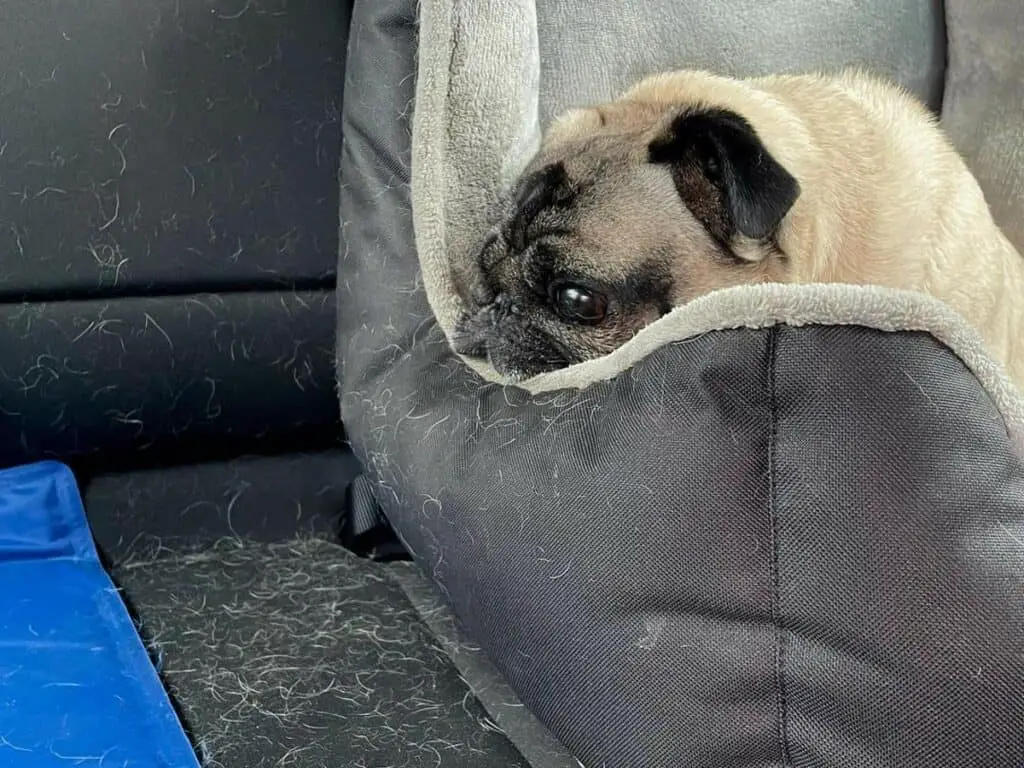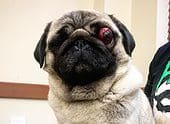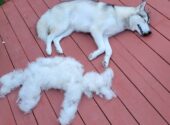Is your heart set on the unusual cuteness of the pug breed? Well, you’re not alone. We also think that these dogs are hands-down the cutest companion one can ever have. Not only are they comical, but they’re also affectionate, playful, intelligent, loyal, and cuddly!
However, pugs can also be prone to shedding. That’s right; if you’re wondering do pugs shed, the answer is yes, and they shed more than other dog breeds.
This article will discuss why pugs shed excessively and how to deal with the shedding process.

What You Need To Know About Pugs Coat and Color
Pugs can be either single-coated or double-coated. They come in various colours: fawn, black, silver, silver, and apricot. White pugs also exist; however, they are a form of albinism and are not actually white. So if you’re buying a white pug, make sure your breeder is telling you the truth about the color.
Besides these colors, there are also those considered trendy and exotic colors. Black, tan, merle, brindle, panda, and chocolate pugs are hard to find and often sold for very high prices. Note that these aren’t pure-bred pugs. One has to breed pugs with other breeds to achieve these colors. For example:
To achieve white, you have to breed a pug and a French bulldog or Pekingese.
To achieve merle, you have to breed a pug and a merle chihuahua.
To achieve brindle, you have to breed a pug and a Boston terrier.
Beware of breeders who refer to these colors as “rare” when the reality is that puppies sold in those colors were deliberately bred.
Do Pugs Shed?
Pugs are known for being very hairy dogs. They also have a lot of hair packed into their little frame. Because of this, they often shed a lot. They will leave bits of hair on your floor, couch, and clothes. Double-coated pugs shed more than single-coated ones. There are also certain seasons where shedding is more frequent.

Why Do Pugs Shed So Much?
Black pugs are single-coated dogs, meaning they shed less often. They’re the best option if you’re not into owning a pug that sheds a lot.
As with any breed, Pugs can experience external factors that cause them to shed more than usual. If your Pug is shedding more frequently than usual, consider some potential causes.
Allergies
When pugs develop an allergic reaction to certain foods or environmental contaminants, they experience itching, licking, or biting their own fur, which could lead to significant hair loss. Pug allergies can be caused by a variety of things, including food, medication, parasites, fleas, and mites.
Pugs shed their fur because of an allergic reaction on their skin when they come into contact with sensitive things. This is a rare kind of shedding that only happens occasionally. Pay attention if something seems off with your Pug’s fur. Even if it doesn’t seem like anything serious, it may be worth checking out.
Hormonal Cycles
Hypothyroidism is a condition in which the thyroid gland produces insufficient thyroid hormones. This leads to a decrease in metabolic rate and energy levels. It also causes a dog to lose its fur, become lethargic, and gain weight.
If your female pugs aren’t spayed, their heat cycles may cause them to shed more than usual during certain times of the year. You could notice that they’re shedding more hair through their heat cycle.
Body Temperature Changes
When a pug’s body temperature rises above 101°F, excessive shedding occurs. Therefore, don’t overwork your pugs in hot weather. A 15-minute walk every day should be sufficient. If you overwork your pugs during warm weather, they’ll shed excessively.
Be sure to check on their temperatures frequently and take steps to prevent them from coming into contact with things that could raise their temperatures. For instance, playing with your dog outside on a hot afternoon may increase your Pug’s body temperature.
Poor Nutrition
A Pug dog’s food needs to be balanced for its health. Like humans, dogs need proper nutrition if they want their fur to stay healthy.
A balanced canine nutrition plan includes the nutrients needed for healthy hair, strong hair follicles, and minimal discharges. Omega-3 fats have been proven to help pugs improve hair health, so adding them to their diets is always a good idea!
Another ingredient that you might consider adding to your dog’s diet is methylsulfonylmethane (MSM). This natural sulfur compound helps support the structure of your dog’s connective tissue and protects against free radicals.
Stress
Just like people, pugs get stressed. Emotional reactions are powerful and can manifest physiologically in your dog’s system. If there’s been a major shift in your home environment, perhaps due to a move, death, or divorce, your dog may be experiencing excessive shedding as a reaction to stress.
If you think your Pug might be experiencing excessive shedding because of stress, do everything you possibly can to provide a regular, predictable daily routine for your dog. Walk your dog at the same times each day, don’t switch up meals or mealtime, and as much as you can, give your dog lots of TLC throughout the day.
Parasitic Infestations
Parasitic infestations and fungal infections cause your Pug to shed its fur. Fleas, ticks, and various other parasitic insects bite your dog, causing an immune system reaction in the dog.
If your dog is allergic to flea bites, it may start scratching itself and lose a significant amount of its coat. Ringworm causes dogs to itch so badly that they begin pulling out their hair.
Diseases and Chronic Conditions
Hyperthyroidism causes excessive shedding in dogs, which is usually associated with the corresponding symptoms:
- darkening of the skin color
- weight gain without eating more food
- augmented blood cholesterol
- gets cold easily and quickly
Hyperthyroidism occurs when the thyroid glands, which are found near the trachea in dogs, are either too active or too inactive. These glands control metabolism and other vital body functions. Fortunately, this condition can be treated easily by a veterinarian.
Tips To Reduce Pug Shedding At Home
Sheds occur naturally, so there’s no way to prevent them from occurring. However, if your Pug sheds excessively, you can take steps to minimize the frequency and severity of the problem.
Brush your Pug’s hair regularly.
When you groom your pet, you’re cleaning its coat so it doesn’t shed. By grooming regularly, you remove the dead hairs before they drop onto your floor and furniture.
The second reason why brushing your dog is important is because it helps spread out your dog’s naturally occurring oils throughout his body. And which in turn can lead to healthier, stronger, and shinier fur.
More importantly, most dogs enjoy being groomed, so in addition to reducing their shedding, grooming them is a great way for you to bond with them.
For short-haired breeds like pugs, a bristle brush is best.
Bathe your Pug regularly.
Bathing helps remove dead or damaged hairs from your dog’s coat. However, there are things you need to keep in mind.
First, choosing a good quality shampoo that contains no harsh chemicals that could dry your dog’s coat out or cause irritation is important. This is why you should not use human shampoos; instead, opt for ones made especially for dogs. Some are also specially formulated to help loosen and remove dead fur while also helping prevent future shedding.
If you want something that’s really gentle on your dog’s skin and one that adds some moisture, you could try making a homemade shampoo using oats instead of commercial shampoos.
Secondly, don’t over-bath your dog. Even if you’re washing your dog properly with suitable soap, frequent baths could strip the natural oil from the coat and cause dryness. How often you should bathe your Pug depends on several factors, including how messy your pet gets, what shampoo you use, and your personal preferences. But since a pug is a short-haired breed, bathing your pet once every two weeks is usually sufficient.
In addition, a blow-dryer is something you can use as part of a complete, three-step shampooing, brushing, and blow-drying routine. Blow-drying your Pug until its fur is completely bone-dry will give it a sleek, shiny appearance. It will look neat and well groomed.
Before even starting to dry your dog, let your dog explore. In an enclosed area, with your pet and the dryer on the ground, give your dog a treat and praise. When your dog gets closer and shows some interest, offer up quality food and praise. This should make your dog feel comfortable enough to go near the dryer.
Keep your Pug hydrated.
Dehydrated dogs shed excessively because their skin dries out too quickly. Dogs who drink plenty of water will not suffer from excess shedding.
But how much water is needed?
There isn’t any hard and fast rule for how much water your pet needs daily. Give your Pug some water if it’s thirsty from being out running around. Besides giving your dog water several times a day, you can give them juicy fruits like watermelon or switch to moist dog food.
Get rid of the fleas.
Flea bites don’t just itch; they can also lead to nasty infections and excessive shedding in dogs. Most often, though, a recommended flea treatment from your veterinarian should take care of these issues. Whether it be a topical flea treatment, oral medication, or another type of flea treatment, your vet may recommend one for you.
It may be hard to believe, but just a few flea bite marks can result in skin irritation that lasts for several days, even after you’ve gotten rid of the flea infestation. This, in turn, can result in itching and excessive shedding. If you want to get rid of fleas as soon as possible, then it’s best to take action now. And if you notice any signs of irritation, contact a vet immediately.
Ensure your Pug consumes a healthy, balanced diet.
Ensuring that your dog is eating a healthy, balanced diet will help ensure that he’s healthy and thriving and will, in turn, help avoid excessive shedding caused by poor nutritional habits.
Many good dog food options are available, but not all are created equal. Some are designed to be especially helpful in reducing excessive shedding. Some dog foods may be better than others because they don’t include certain fillers, preservatives, and other artificial ingredients, which may cause allergies and skin irritations. And some contain an optimal level of omega-3 fatty acid and other essential vitamins and minerals to help with hair loss.
It pays to do some research before buying dog foods. Of course, you don’t need to buy expensive dog foods, but the type of dog foods your pug eats can greatly impact the amount of shedding.
Talk to your veterinarian about which food best suits your pet, as they should be capable of giving you a suggestion depending on your pet’s requirements.
Give your Pug plenty of exercises.
Regular physical activity won’t prevent your Pug from losing its fur, but a well-exercised pet is likely to develop healthier and shinier coats. Also, regular physical activity can help relieve stress and anxiety in dogs which are associated with higher than average levels of fur loss.
Adult Pug Exercise Needs: Pug owners know that adult pugs need less than an hour of physical activity each day. They’re not really into walking for several hours. Instead, they prefer to spend most of their time sleeping.
If you’re looking for a fun way to motivate your dog to exercise, consider doing something different than just walking. For example, you could split up a long walk into two shorter ones. Or you could mix things up by playing some fun exercises instead of walking.
Pug Puppy Exercise Needs: With pug puppies, the general rule is that five minutes of formal exercise per month is enough for them. However, their joints may become deformed if over-exercised, leading to joint pain later.
Senior Pug Exercise Needs: You might be surprised to learn that pugs can actually become seniors at an earlier age than humans! By this point, they may start showing signs of aging, including slower movement and decreased energy levels. If you see these changes, it’s likely time for them to cut back on their exercise routine.
Consider dog supplements that reduce shedding.
Nothing beats good, balanced dog food. However, some great supplements are available for dogs designed to help them shed less often. The best dog supplements for dry skin contain natural ingredients, minerals, and nutrients that can help control excessive shedding or prevent it from happening.
Dry skin supplements may include zinc, biotin, and essential vitamins that help keep your dog’s coat healthy and shiny.
Try these home remedies.
Olive Oil: Olive oils contain powerful moisturizing properties, so adding them to your dog’s daily meals will keep his skin healthy and prevent him from scratching excessively. They’re also rich in vitamin E and Omega 3 fatty acids, promoting overall health and skin condition.
Besides, olive oil has been proven to help dogs get rid of mange and prevent their skin from becoming dry and flaky. Use 1 tbsp of olive oil per 10 lbs of your pet’s body weight daily.
Coconut Oil: Coconut oil can add moisturization to your Pug’s hair and keep it soft. It also works great as an antifungal treatment for dry, itchy spots. You can apply it directly to your Pug’s coat or mix it into his food. Just make sure not to give him too much!
Related Questions
What months do pugs shed?
Pugs shed all year. However, they lose a bit more hair than usual when temperatures change, like during Autumn and Spring.
How bad do pugs shed?
Though pugs are considered to be heavy shedders, there can be differences between black and fawn coat colors. The level of shedding may range from mild to severe.
Do black pugs shed excessively?
Black Pugs tend to be single-coated, so they’re usually not as prone to shedding. If you’re looking for a black dog who doesn’t need brushing often, then the Black Pug might be your best choice.
References
Wikimedia Foundation. (2022, August 2). Methylsulfonylmethane. Wikipedia. Retrieved August 29, 2022, from https://en.wikipedia.org/wiki/Methylsulfonylmethane.
Scholz, M., & Von Reinhardt, C. (2006). Stress in Dogs: Learn how dogs show stress and what you can do to help. Dogwise Publishing.




